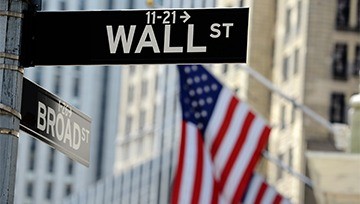Next Stock Market Crash Prediction Talking Points:
- Does the return of volatility to equity markets suggest a stock market crash is on the horizon?
- The S&P 500 has climbed above the competition, but is its valuation deserved?
- The cases for continued growth are few, but present nonetheless
- If a stock market crash were to occur in 2019, what might that look like in comparison to the Great Financial Crisis?
Stock Market Volatility and Event Risk Grows while US Equities Outshine the Competition
The concluding months of 2018 were chocked full of volatility and event risk. Since September, the S&P 500 retraced completely for the year and has been trading lower than it opened on January 1st, 2018. Further still, various economic indicators are flashing red leading some speculators to believe US equities - and the stock market in general - are soon to crash. And, given the valuation of the S&P 500 to other global equity markets, concerned investors may be onto something.
The S&P 500 Outpaced Developed Peers in Recent Years

Further reading: Learn tips and strategies to trade the S&P 500.
As you can see from the chart above, most equity markets stood on equal footing at the start of 2009. The Great Financial Crisis appeared to be the great equalizer at the time but in the decade since, the S&P 500 has been one of the strongest performing equity markets in the world.
The US index traded largely in-line with global competitors until mid-2013 and only since late 2017 has it outpaced the German DAX. Why then, has the S&P 500 been able to sustain such a momentous run despite other equity markets slowly returning to Earth?
There is a list of reasons for this particular asset's remarkable climb. Starting in 2016, the election of President Trump spurred business optimism in the United States as many believed him to be a “pro-business” Leader of the Free World. This optimism likely contributed to 2017’s uninterrupted climb with other major indices enjoying similar growth.
Tax Cuts Boost Profits, Share Buybacks and the S&P 500
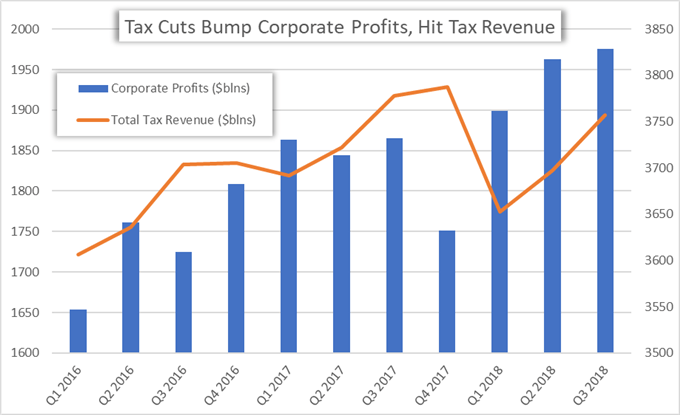
Data sources FRED, BEA
Investor’s suspicions were confirmed in late 2017 when corporate taxes were slashed to 21% from 35%. The cut saw corporate profit bounce and many companies subsequently announced share buybacks which further buoyed share prices.
Anecdotally, AT&T announced a one-time $1,000 bonus to all employees because of the cuts while Walmart announced a pay hike for employees. Materially, corporate profits climbed to record heights. The optimism and euphoria in-turn influenced GDP projections for the United States even further, remarkable considering they were already heightened compared to other developed economies.
United States GDP is Projected to Outpace Other Developed Economies
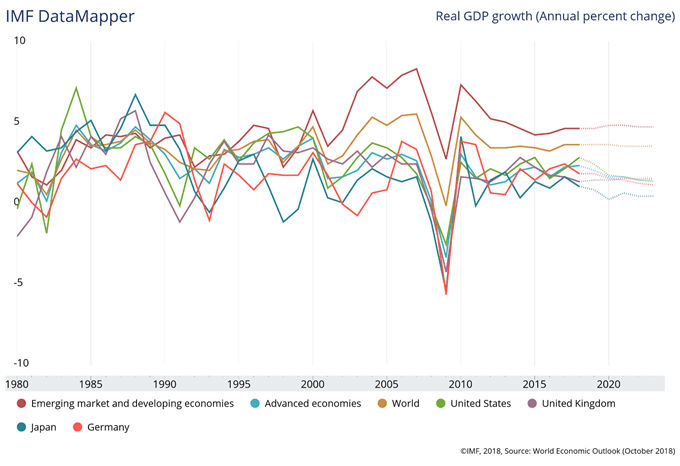
The projections increased revenue outlooks for many US firms and share prices subsequently demanded a premium to account for future growth which further inflated the S&P 500’s market capitalization. While growth forecasts in foreign developed economies slipped in comparison, intangible threats to those same economies arose.
Many of these threats are ongoing and many show no immediate path to resolution. At the forefront, Brexit jolted the United Kingdom's and European Union's growth forecasts. Uncertainty remains as the divorce terms are still unclear which will keep growth forecasts, currency valuations and stock market valuations are all discounted.
On a broader basis, Brexit has ignited concern about the integrity of the entire Union. Recent Italian budgetary issues have raised concern that conditions like those during the Eurozone Debt Crisis could be revisted. These troubles have been further stirred by France. After a series of concessions to protestors, French President Emmanuel Macron has veered the second largest economy in the Union into a fiscal red zone having surpassed projected debt limits and will surely face warnings from Brussels.
In total, Europe has three of its four largest economies in a gray area of uncertainty or in breach of regional laws. To compound this, the overall integrity of the European Union has been called into question. It is no wonder why a regional economic powerhouse like Germany, with few issues of its own, would fall behind the S&P 500 which has enjoyed relative stability.
Has the Bull Market Run its Course?
While the United States may enjoy stability at present, the lack of a bad thing does not constitute a good thing. As reasons for continued growth seem limited, many economists have issued warnings of an imminent downturn which could lead to the next stock market crash. Still, there are a few factors that could keep us afloat in the short-term.
At the top of the list, a US-China trade war resolution would drive markets higher. A conclusion to the economic battle would increase trade, reduce costs to manufacturers and consumers and generate positive sentiment. Growth forecasts would be revised upward, and global equities would likely enjoy a rally on return to the status quo. But any resolution seems far off at this time and may not occur before the S&P 500 breaks down completely.
Robust Consumer Spending Could Keep Growth Afloat
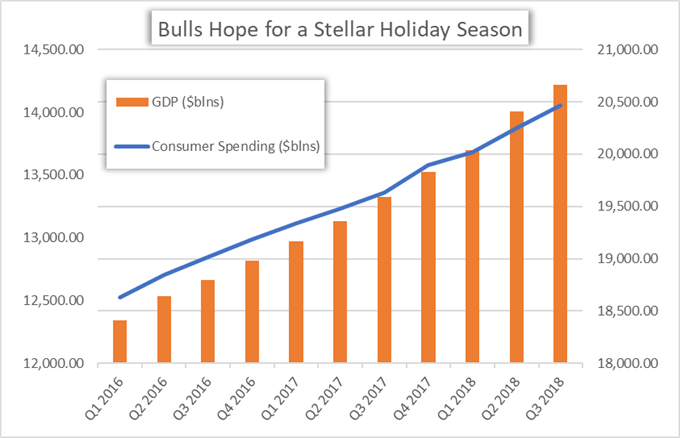
Source: BEA
A more immediate reason for optimism may be robust consumer spending. Months of cycle-low unemployment and steady wage growth will likely result in a stellar holiday season for retailers and the data could impact sentiment. Materially, holiday sales will come into play during earnings season and if the market enjoys a string of strong performances, it could generate some buoyancy for equity markets over the longer term - therefore stalling a potential stock market crash. Yet many remain unconvinced there is anything that could reverse the course equities are on after the inversion of the yield curve.
Bubble, Crash or Slow Decline of Stock Markets in 2019?
Whether there is room for bulls to run or not, it is important to explore the possibility of a substantial or sustained decline regardless. To get a sense of what may occur, historic economic events like the Great Financial Crisis (GFC) can give a glimpse of things to be wary of.
With the gift of hindsight, the GFC seems like an obvious bubble waiting to pop. Unfortunately for current investors bubbles are rarely witnessed by the broader market until after they pop, apart from Bitcoin perhaps. Another difference between the current economic climate and the previous is the state of commercial banks. The Fed has reviewed the largest US lenders and imposed stress tests to ensure a crisis like 2007 does not happen twice.
With that in mind, the Fed’s Financial Stability Report did highlight elevated levels of corporate debt. While some speculators believe corporate debt is currently in a bubble, detractors believe interest rates would need to rise further before the pressure of interest payments become too burdensome for corporations to repay. Recently Fed officials have stepped back from their hawkish stance and for some, the case for rate hikes in 2019 is weakened. While hike expectations have slipped, it is widely believed two increases in the year ahead remain in the cards.
Further Reading: A Brief History of Major Financial Bubbles, Crises and Flash Crashes
Corporate Debt Continues to Climb even as Rates Rise
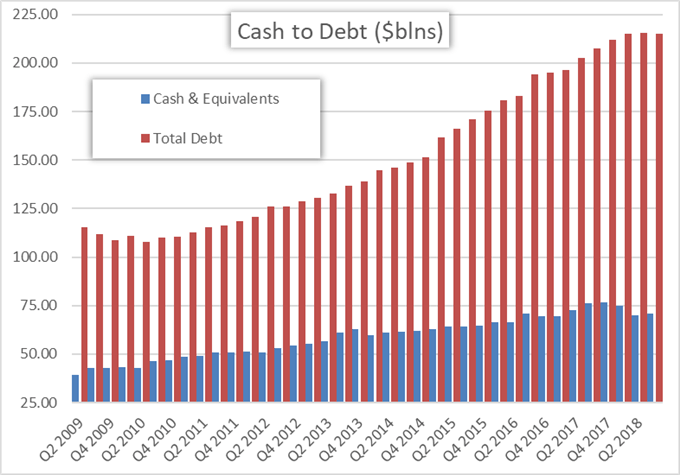
Source: BEA
Consequently, the impact of a more expensive Dollar would pressure emerging markets and hamper US exports. Once combined the two factors would exert significant downward pressure on the global growth outlook which many - including International Monetary Fund Chairwoman Christine Lagarde - have already called into question.
Further reading: Our first quarter forecasts for equities, commodities and currencies.
Given the warnings from the Federal Reserve and economists like Ms. Lagarde, it seems a culmination of factors pose risk to the US economy and the equity markets within. A bleak outlook for global growth and equity growth have weighed on sentiment and a continuation of the recent declines seems likely at this time.
A sustained decline could be amplified by contagion as investors attempt to get out before losses mount. In turn, a complete risk-off attitude could pull the bottom out from underneath the S&P 500 and result in a crash. While the timing and depth of any upcoming crash are unknown, it is important to be prepared for any eventuality. An adequately hedged portfolio can limit losses and even generate profit in the event of a serious downturn. Similarly, bear markets can provide lucrative opportunities for traders with the right strategy and skillset.
--Written by Peter Hanks, Junior Analyst for DailyFX.com
Contact and follow Peter on Twitter @PeterHanksFX
Read more: What is the Fed’s Number One Fear?
DailyFX forecasts on a variety of currencies such as the US Dollar or the Euro are available from the DailyFX Trading Guides page. If you’re looking to improve your trading approach, check out Traits of Successful Traders. And if you’re looking for an introductory primer to the Forex market, check out our New to FX Guide.


